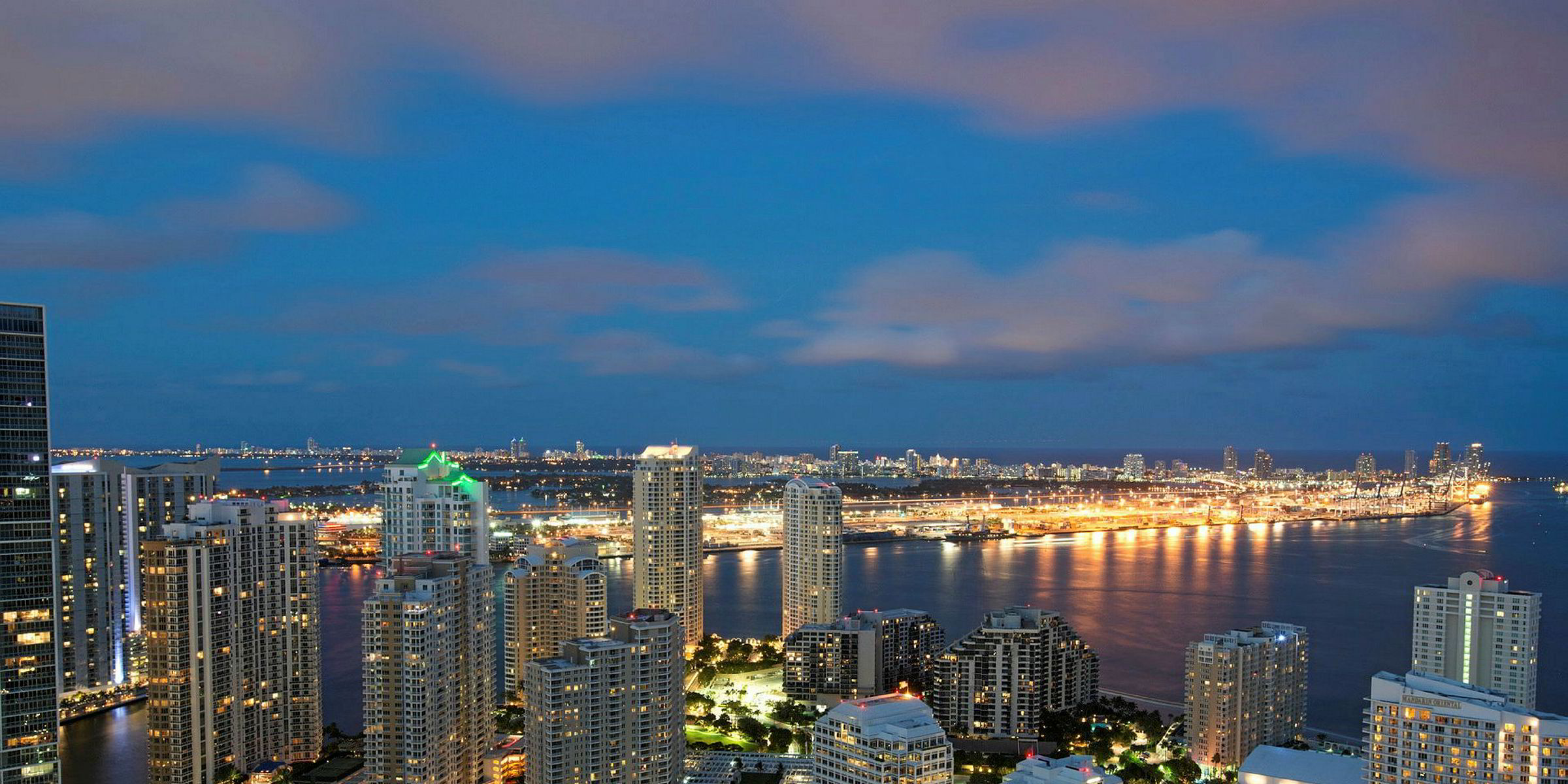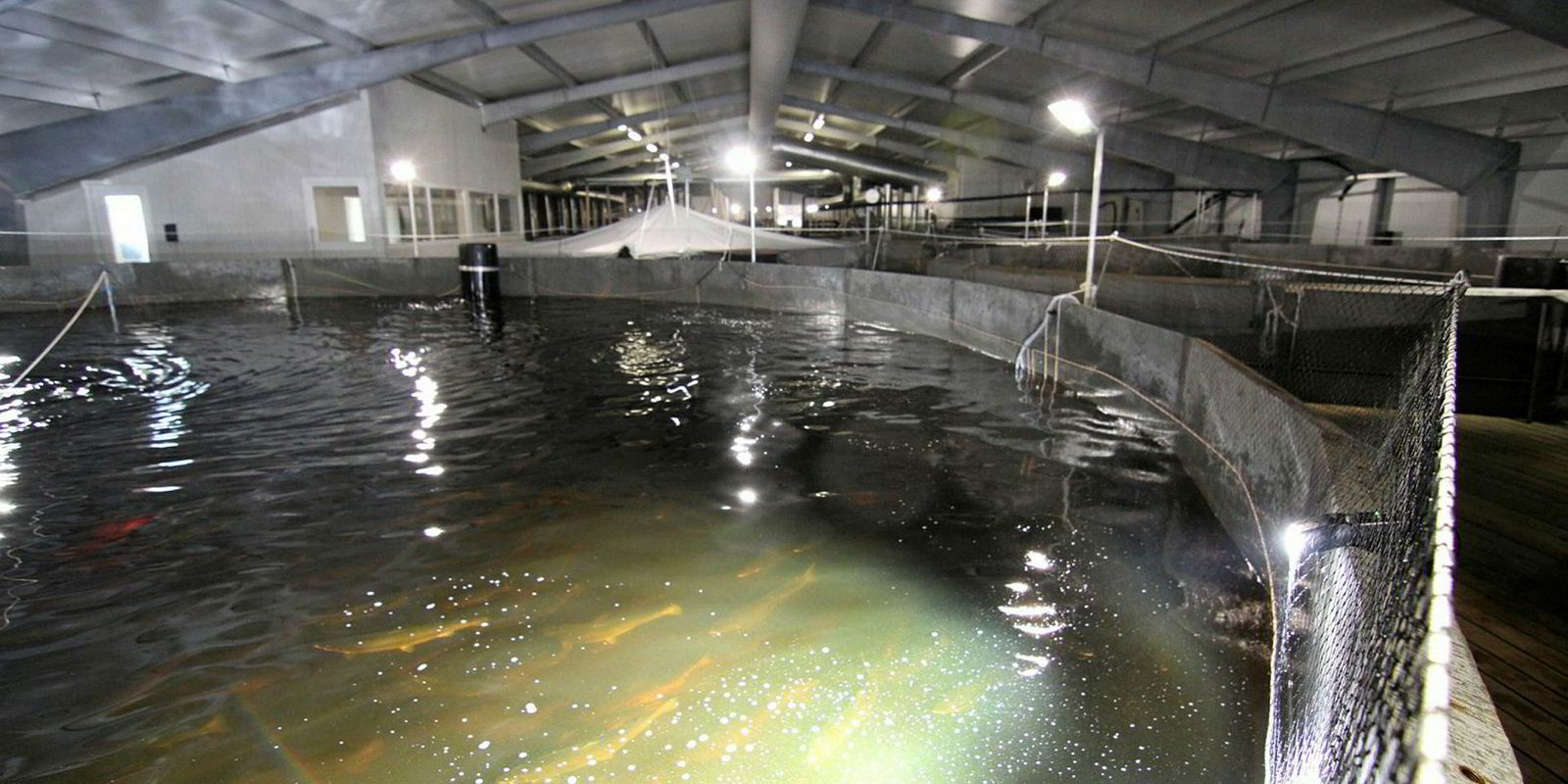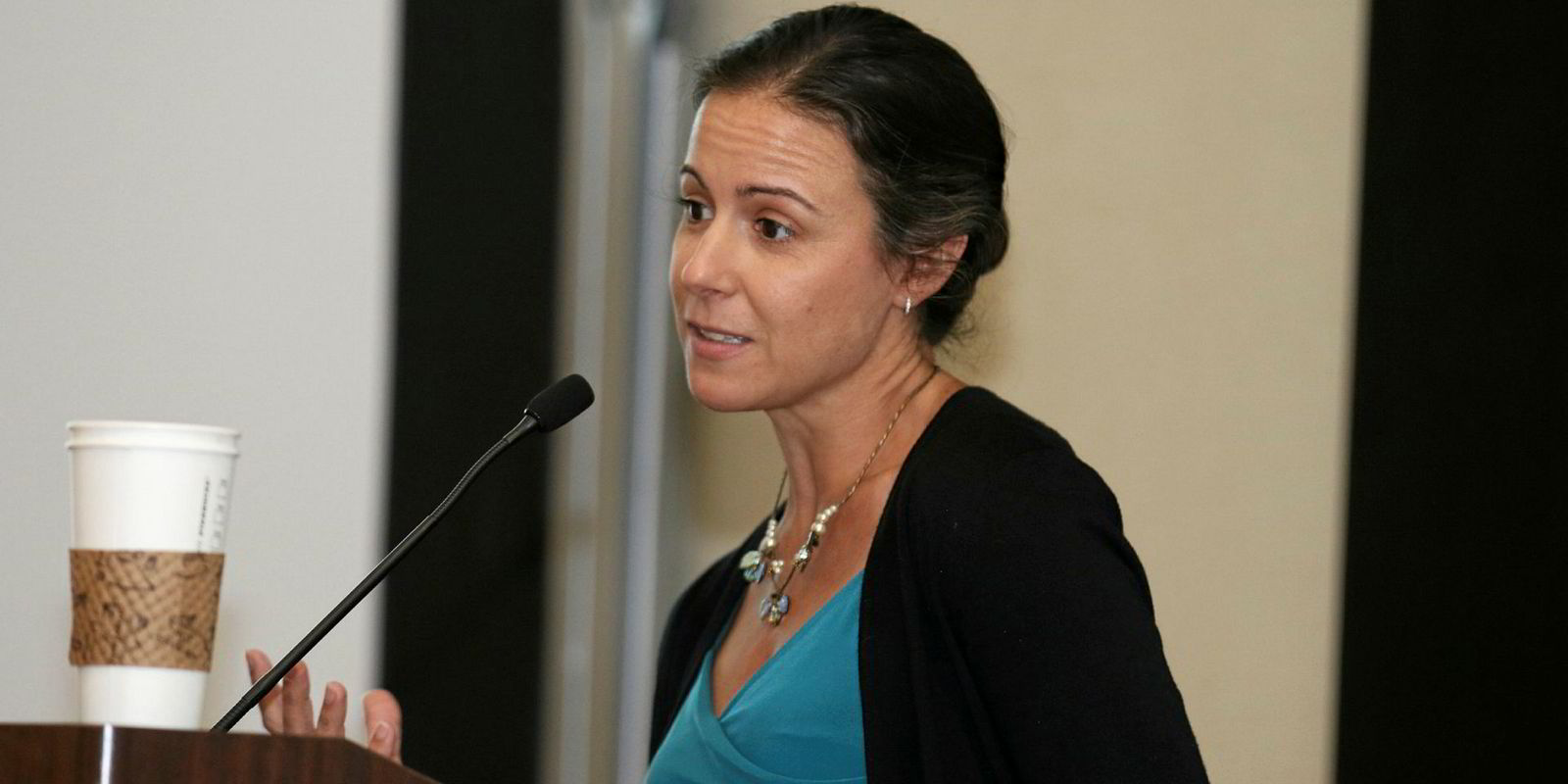Tuesday, Dec. 5, 5:30 p.m. EST
Farming salmon in the Swiss Alps
A new concept of recirculated aquaculture system (RAS), the RAS 2020, is already delivering the first batches of Atlantic salmon in Switzerland after successful trials with land-based farmed trout.
Smoltification occurs in separate RAS tanks, and the company imports eggs from Iceland, Thomas Hoffmann, from Swiss Alpine Fish, told IntraFish.
The innovative technology consists of a circular tank with two different rings: in the inner ring, salmon is grown up to one kilo, and in the outer ring salmon is grown from one to four kilos.
The first batches were harvested recently, at an average weight of 3 kilograms. The target is 4 kilograms WFE, with a production cycle from egg to harvest of 24 months, Hoffman said.
The system is suitable for the production of kingfish, salmon and trout, but the company will focus on the production of salmon for the Swiss market.
The current capacity of the farm is 600 metric tons a year.
--------
Tuesday, Dec. 5, 4:25 p.m. EST
‘Land-based’ is a plus at point of sale
Far from being a negative attribute, the “land-based raised” characteristic is a selling point for customers worried about the environment and sustainability, said Daisy Berg, seafood program and category manager for New Seasons Market.
The grocery chain sells only fish rated yellow or green by the Monterey Bay Aquarium Seafood Watch program, and began to sell land-based raised salmon supplied by Atlantic Sapphire last year. Before that, it did not have any farmed Atlantic salmon.
The chain is bringing in around 1,000 pounds of salmon from Denmark a week, and it has had a consistent supply since April.
“To be able to say that it’s land-based and get rid of all the negative connotations of ocean farming in terms of environmental impact is very important,” Berg said.
--------
Tuesday, Dec. 5, 1:45 p.m. EST
Quality inside and out
What do feed companies take into account when formulating feed for RAS sites? One of the priorities is fecal quality, said Alex Obach, managing director at Skretting Aquaculture Research Centre.
The aqua-feed giant now provides diets to 120 RAS units around the world.
There are certain specific needs in recirculated systems, but one of the main differences with sea pens is the need to consider feed waste and feces consistency. In a contained environment, it is important to obtain solid waste that does not increase turbidity to the water, and which is easily separated for optimal water filtration and to be reused for other purposes.
Feed formulations for different farming systems requires expertise in different fields, as well as specifically design systems for research and development. There is as well a major need for rapid analytical tools to conduct reviews on raw materials and complete feeds.
Minimizing excess nutrients, for example, is crucial to improve digestibility.
A range of factors affects protein digestibility, such as the raw material used. However, calibrating the different components of feed can result in high digestibility, the consistency of the feed and duration pellets stay suspended in water, and ensure proper levels of nutrition are maintained.
Prominent lines of research on waste prediction models are based on the determination of feed quantity needed, the exact composition of the feed, the digestibility of the feed components and the body composition of the fish, which can suggest accurate estimates of retained nutrients, metabolic loss and feed waste.
---------
Tuesday, Dec. 5, 12:20 p.m. EST
The not-so-bright side of RAS
Artificial light continues to be a major challenge in recirculated aquaculture systems (RAS), just as it used to be in traditional salmon farming.
RAS farmers are finding the same problems Atlantic salmon growers used to have with short-lived, indirect and low-intensity clarity in pens, which affects fish behavior, feed performance and sexual maturation of the fish.
This is generally well controlled now in net pens, said Christopher Good, from The Conservation Fund Freshwater Institute.
Sexual maturation is a natural process, but it’s influenced by a number of factors, including photo period, water temperature, feed intake and energy levels, lipid reserves, nutrition, growth rate and stock genetics.
With artificial lighting, farmers aim to optimize light and clarity for better performance by simulating natural conditions and “luring” salmon into postponing sexual maturation, which normally results in decreased growth and feed conversion, reduced fillet yield, reduced product quality and increased susceptibility to opportunistic infections.
However, there is a significant lack of knowledge on optimal light conditions in closed-containment operations for post-smolt production, said Jelena Kolarevic of Nofima.
This, she said, is causing important economic losses, with companies not fully understanding the needs of the fish in RAS and investing money in systems that sometimes are not optimal.
“Light producers are dictating what we are using in RAS systems, however, we do not take into account fish perspective,” Kolarevic needs.
Recent studies carried out by CtrlAqua show the importance of light intensity in fish performance and, in turn, the impact of water turbidity in light penetration.
“Research shows that flow-through systems directly under the light have a much higher penetration of light than RAS sites. Even with much stronger light you wouldn’t have that much light penetration in recirculated aquaculture.”
There are still many unanswered questions regarding the best light technology, the intensity, solutions regarding homogeneous lighting such as ceiling lights or direct illumination with spotlights.
In addition, it is still unknown the full impact in fish performance for salmon not receiving natural light.
Documenting performance, light spectra covered by the different technologies as well as the intensity are the main focus for identifying the optimal use of light in RAS facilities, researchers said.
---------
Tuesday, Dec. 4, 3:01 p.m. EST
Is there a formula to land-based aquaculture?
Icelandic Atlantic charr land-based farmer Matorka, which has plans to hit 3,000 metric tons of production by 2020 and is waiting for licenses to reach 6,000 metric tons by 2023, has some clear guidelines for the economic viability of land-based aquaculture.
The No. 1 secret key to success for them was to incorporate only tried and tested technology.
“We’ve taken the best from the industry, we see what works and scale it up,” said Arni Pall Einarsson of Matorka.
But there are other cost-related priorities to take into account for a viable operation, he said.
Farming a species that can obtain a strong price becomes crucial -- high prices are the key to covering bills and costs of production.
And of course, in terms of resources, location becomes the key strategic point in an operation of this kind.
“We in Iceland have certain resources that aren’t available everywhere: unlimited access to groundwater, geothermal energy and hydroelectricity, which is not only green but also inexpensive, and allows us to keep electricity to a minimum,” Einarsson said.
In terms of design and engineering, it helps to have a design scrutinized to cover all the basis, and having a contractor at a fixed price has proven “extremely valuable.”
And of course, access to feed, labor, know-how and professional services, as well as proximity to an international airport are very important to reduce logistical risks, and costs.
--
--
Tuesday, Dec. 4, 1:40 p.m. EST
Do closed-cage farms have the worst of both worlds? Maybe not
The aquaculture industry seems to be skeptical on closed-cage fish farming, with some saying it has the worst of land-based attributes (high costs) and traditional net pen farming (sea-based problems). But that does not seem to be the case with Norwegian AkvaFuture.
“We have been very lucky. This design is very promising, we have produced around 6,000 metric tons in total in two years, with no mishaps, the quality of the fish is very good, it looks like that the fish has good growth, feed ratio is 1.056 kilos per kilo of fish, energy consumption is low, totally without sea lice and capital expense is closer to traditional farming than to land-based,” said Rognvaldur Gudmundsson, project manager at AkvaDesign.
The company plans to farm 8,000 metric tons of salmon in 2019. However, it does not own any licenses, and has no guarantees that current leases will be renewed, he said.
--
Tuesday, Dec. 4, 11:25 a.m. EST
The risk is lower than ever before
The clear darling in land-based salmon farming, Atlantic Sapphire, which recently stocked 400,000 Atlantic salmon eggs from Iceland in its Miami facility and will stock another 400,000 eggs from Norway this week, claims extremely high levels of quality control is one of the keys to its current and future success.
Much of that focus comes from the lessons learned at its Denmark operations, Jose Prado, CFO and EVP of the public-listed company said.
The advantages of land-based aquaculture versus traditional fish farming are well known, as are the risks of the high-technology production system.
“Atlantic Sapphire is based on unprecedented learnings, a strategic plan in Florida, and capital,” said Prado.
“In relation to risk, we’re in the risk mitigation business. But the learnings that we’re getting from Denmark are invaluable as we look to bring the US operation online.”
Current measurements around feed quality, water quality, temperature, oxygenation and all variables is completely different to what it was two years ago, he said.
“The risk is lower than ever before," he added.
Atlantic Sapphire’s lead feed supplier is BioMar, from Denmark, but the company is currently in talks with other major suppliers.
--
Tuesday, Dec. 4, 10:03 a.m. EST
--
Tuesday, Dec. 4, 9:12 a.m. EST
What people need to know
Data will not fundamentally change the way people eat the way the seafood industry wants.
Fish is intimidating, people do not know what to do with it, and feed conversion ratio does not drive purchasing decisions by consumers, said Jacqueline Claudia, from frozen seafood supplier Love the Wild.
To get people to eat more fish, seafood needs to be brought to the food people already buy, and of course, needs to taste great, tell the right story and be competitive on price.
“There are a lot of things to love about sustainable aquaculture: we raise fish very well, we feed them sustainable diets and they’re grown in a sustainable environment, and we are the ones bringing that to the consumer,” Claudia said.
“But people don’t need to know all the cool stuff. Them understanding all of the details can be important to you and to me, but it doesn’t really matter. The thing that matters is that they eat it, that they eat it is what will change the world.”
--
Tuesday, Dec. 4, 8:33 a.m. EST
Creating seafood evangelists
Barton Seaver, founder and Chief Education Officer at the Coastal Culinary Academy, said he has made it his mission to get people eating more seafood. And for that, he said, the industry has to create a "generation of evangelists" around seafood.
"Seafood is the tool through which people will thrive. We need to be eating a lot more seafood for our environment," Seaver said.
Education, he said, is at the center of a lack of social license not just in aquaculture, but in seafood itself.
“Furthermore, we need to increase the volume of conversation in the media. For too long we have been on the defensive, only responding to the negative messages in the media, but the bottom line is we need to flood the market with pro-seafood messages that begin to cultivate a culture around seafood."
Sustainability does not have to be seen as the way to minimize our impact on the environment, but as a way to maximize the impact the environment has on us.
But sustainability also goes way beyond environment, from an economical viewpoint, it is the means for empowerment of women in developing societies, too, he said.
"It’s not enough anymore to just tell people what you’re not: gluten-free, mercury-free, Fukushima-free. No. Tell people who you are, what you do and the principles you stand for, people might see that you’re on their side, and that they’re on yours.”
--
Tuesday, Dec. 4, 8:00 a.m. EST
Focus on sustainable innovation
The Aquaculture Innovation Workshop (AIW) is being held this year in Miami. Over the next two days, a total of 27 speakers will give their take on the latest developments in aquaculture technology to an audience of 250, with a focus on land-based technologies, recirculated aquaculture systems (RAS), and sustainability.
IntraFish will blog live from the event, so keep coming back for all the news and follow us on Twitter @IntraFish.
--
OUT NOW! IntraFish's land-based salmon farming report. Download today!



